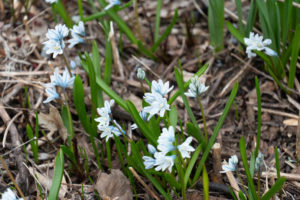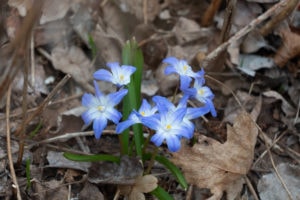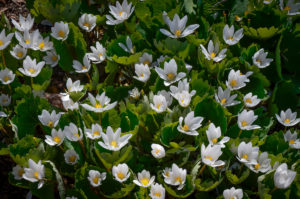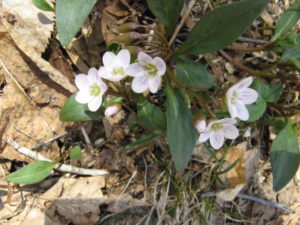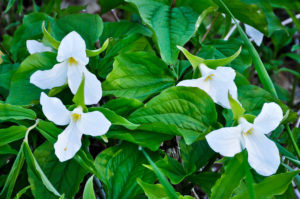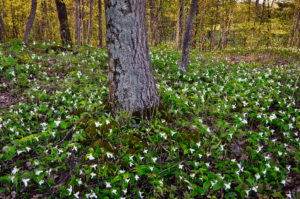Teasing April
We are now well into the third week of April and more than a month past the Vernal Equinox–that precise point in the calendar when, all over the planet, daytime and nighttime are essentially equal.
This celestial marker, which occurred this year on March 20 at exactly 5:58 PM, is also supposed to signify that we have somehow magically passed from ‘Winter’ to ‘Spring’.
But in reality, as we all know, new seasons do not appear on command at predetermined times. Here in Vermont spring, in particular, always seems to arrive both slowly and gently.
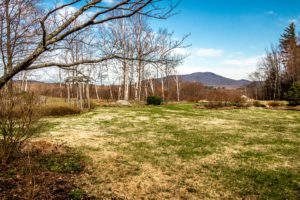
It is the third week of April and although the grass is starting to ‘green-up’ I must look up close to see the early flowers.
Teasing April
April is like a playful tease as gentle spring emerges on its own sweet time. As this picture shows, it is the third week of April, and our garden is barely awake.
But if I look close to the ground I find little treasures popping up all around.
And we gardeners cherish each and every one of these diminutive pleasures of early spring, both for their beauty and for their message that our natural world is coming back to life.
Snowdrops—‘Nature awakens’
Just ten days ago our ‘barn slope’ was still covered in several inches of snow. Finally, after a few warm days, the snow melted away, and already the snowdrops are in full bloom—a precious miracle that should last at least another week.
Once the snowdrops have finished flowering their green leaves will remain for about a month as the plant makes food for the coming year. Then, almost overnight, the leaves will vanish too and everything is hidden until the following spring.
Of wood frogs and serviceberries
A few days later the wood frogs arrived in our pond to begin their annual mating ritual–which always sounds like dozens of quacking ducks. I have no idea what triggers their arrival each year. But it is a good thing they did not decide to come the week before–when we had a couple of cold nights causing the pond to freeze over once again.
Another eagerly awaited sign of spring is that just this week the buds on the serviceberry trees outside our kitchen window are getting noticeably fatter. But I know full well I must wait another ten days before that special time when they burst into flower.
The first daffodils
It was just a week ago when the first cheery yellow daffodils started to bloom along the south wall of our house, where the extra warmth encourages that burst of exuberance I crave each April.
And now more daffodils, mostly the varieties designated as ‘early’ in the catalogs, have started to bloom in other parts of the garden too.
But these April daffodils are merely a tease. Here in the mountains it will be mid-May, when the crab apples flower, before broad sweeps of white and gold daffodils fill my garden beds, signifying that spring is here in all its glory.
Little treasures
About ten years ago I tucked some of the so-called ‘minor bulbs’ around the place. My favorites include Star Flowers (Ipheion) with the palest blue flowers, as well as the slightly darker Glory of the Snow (Chionodoxa) and the closely related darker blue Scilla.
And over time these little treasures have not only multiplied in place but they also self-seed and spread themselves around, popping up in unexpected places including the lawn and between the stones of the patio.
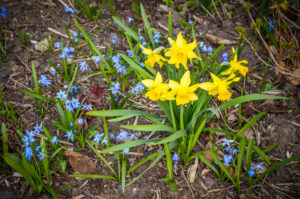 And for me nothing beats the sight of a clump of early yellow daffodils surrounded by lots of clear blue scilla or chionodoxa.
And for me nothing beats the sight of a clump of early yellow daffodils surrounded by lots of clear blue scilla or chionodoxa.
Coming soon
It was just today when I spied groups of those tell-tale cigar-shaped bumps in the soil, signifying that my bloodroot (Sanguinaria canadensis) is getting ready to bloom. In a few more days their pristine white flowers will emerge from the ground, each protected by its own tightly coiled leaf. And amazingly, to preserve its precious pollen, each flower will close again each night or when it rains.
About fifteen years ago I decided to clear our ‘barn slope’ and plant a garden. There was little of interest to save, apart from a tiny patch of wild native bloodroot. Every year I had marveled as its clear white flowers, like miniature anemones, emerged between the thick grasses and ferns which, at that time, completely dominated the slope; I was in awe that such a delicate plant could survive under such adverse conditions.
I carefully dug the single rootstock which easily broke into smaller pieces that indeed exuded a reddish liquid reminiscent of blood. I tucked the pieces into various shady corners around my garden, and now each spring I am rewarded with dense patches of delicate white flowers, followed by attractive scalloped leaves, which unless the summer is excessively hot, will remain throughout the season.
I am also waiting and watching for the creamy-colored Hellebores up on the barn slope to bloom.They seem late this year–but then again each year is different. So I am still hopeful that they made it through the winter.
Location is everything
Of course the exact timing when all this magic happens varies tremendously depending on your location. We live fairly high on the western slopes of the Green Mountains and, even a few miles away, down in Brandon or Middlebury, these events often occur a full ten days earlier.
And it was back in mid-March when my son, who lives in South Carolina, sent me a photograph of his crab apples which were already in full bloom! It must be summertime down there by now!
Spring in the forest:
In last week of April and into early May our forests suddenly come alive with wide swaths of Spring Beauties as well as clumps of Bellwort, Squirrel Corn, Trout Lilies, Dutchman’s Breeches and Trillium, and many other lovely wildflowers.
Many of these beloved early wild flowers are known as ‘spring ephemerals’– amazing perennial plants which are perfectly adapted to life beneath the tall deciduous trees of the forest.
The life cycle of those incredible ‘Spring Ephemerals’
In early spring in the forest, before the trees leaf out, the sun is able to shine right down through the trees to the ground where it quickly warms the soil.
And during this brief period of time of sunshine, before the emerging leaves shade the soil, spring ephemerals are able to complete their entire annual life cycle. First they put out flowers and leaves, attract pollinators and set seed, all the while photosynthesizing and storing enough food to carry the roots of the parent plant through the coming year.
With these essential activities accomplished, they shed their leaves and retreat back beneath the ground, only reemerging the following spring.
Spring ephemerals in our gardens
Ephemerals are also the mainstay of the spring garden. Many, like daffodils, crocuses and scilla, have bulbs or corms which can be readily purchased at garden centers and planted in the fall.
However, as you probably know, daffodils and other bulbs can also multiply by making additional side bulbs. And in fact, over time, you may find you have too many daffodils in your flower beds.
The solution is to relocate some to other spots in your garden. But plan to do this in late spring, while the leaves are still green and BEFORE everything has disappeared from sight under the ground.
Gently dig up the entire clump, carefully separate off the side bulbs and replant them someplace else around your property.
And, since daffodils are tough plants, they can easily survive in a meadow setting where the grass is only cut once a year. So every year in late spring I make been digging some of the bulbs from my flower beds and planting them in the rough grass along the roadside

It will be a few more weeks before this native of Southern Appalachia, Little Sweet Betsy (Trillium cuneatum) flowers in my Goshen garden
Others ephemerals, including Virginia Bluebells and various kinds of Trillium which both flower here in May, are actually have rhizomatous roots. American Meadows, in Shelburne Vermont, carries many kinds for that you can plant either later this spring or in the fall.
Before choosing, take a bit of time to learn about their various natural environments and then select those that match the conditions in your own garden.
As a case in point, the lovely White Trillium (Trillium grandiflorum) naturally occurs in the alkaline soils along the limestone cliffs of western Vermont, would be a perfect addition to your garden if you have alkaline soil. However its two cousins, the Red and Painted Trillium, (Trillium erectum and Trillium undulatum) thrive in the acidic upland woodlands around here and consequently are perfectly at home in my garden where the soil is also acidic.
Planning for summer
In my garden I like to plant spring ephemerals among ferns and summer-flowering perennials. This way I will not be left with bare patches of soil after the ephemerals die back. To avoid accidentally disturbing them later in the season I usually mark the planting spots with small sticks.



